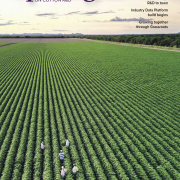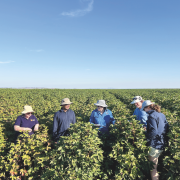Consultation is underway with growers around a model for native vegetation management on cotton farms. It’s a part of the process to create targets for the Australian cotton industry’s Sustainability Framework PLANET. PEOPLE. PADDOCK.
Cotton’s sustainability consultant Chris Cosgrove explains why.
When it comes to native vegetation on cotton farms, we know most growers want to do the right thing: 79 per cent of growers in a CRDC biodiversity survey said it’s important to do what they can to protect biodiversity. A similar number would enter into a partnership to improve biodiversity on their farm.
Growers also tell us they have a common barrier when it comes to managing native vegetation: it’s not seen as core business. While they are busy managing feral pests and weeds, many growers see managing native vegetation as a separate and lower priority activity, rather than seeing native vegetation as having a complementary fit within a modern and productive farming system.
This is not new, but now there is an urgent need to address this thinking.
Many of the people all farmers around the world rely on – customers, banks, governments, local communities and others – are starting to treat farm native vegetation impacts as seriously as they do farm greenhouse gas impacts. Our monitoring of global sustainability frameworks shows us that the same pressure on supply chains to reduce greenhouse gas emissions will now be applied to supply chains to reduce their impact on native vegetation. So, just like customers expect us to report greenhouse gas emissions from cotton production, very soon customers will expect us to report native vegetation on cotton farms.
The positive news is the opportunities these trends offer us.
We don’t want to wait to be told what to do by customers and governments. Instead, we see an opportunity to create a voluntary, industry-scale approach that makes sense for Australian cotton farms, still meets customer expectations, and gives us a chance to shape the narrative instead of being dictated to. Cotton industry researchers have been working for more than two years on this opportunity. They have developed a model that has the following.
- Regionally appropriate cotton native vegetation targets, directly aligned to the priorities of local Natural Resource Management (NRM) organisations to make it very clear what practical, voluntary actions – if any – can be taken on a cotton farm.
- Consistent native vegetation indicators and definitions, aligned with customer sustainability frameworks to measure progress, at no cost to growers, to show we’re getting it right as an industry.
- All the grants, biodiversity payments, tools to measure impact, advice, materials and other support brought into one place to make it much easier for growers to take action if they want to.
The Sustainability Working Group, led by CRDC and Cotton Australia, is consulting with growers to explain this model in detail and to seek feedback. The model will be refined based on feedback from growers.
And, given most cotton growers are mixed farmers, the cotton industry is also talking to other industry’s sustainability frameworks, like beef, sheep and grains. The aim is for different governments and agriculture sectors to be working together to have consistent native vegetation definitions and metrics, to coordinate work avoid duplication, and to give clarity and coordination to all farmers.
This work puts the Australian cotton industry in a great position to respond proactively and take advantage of emerging market opportunities.
It also makes it easier for more growers to gain value from having native vegetation on farms. Growers tell us the value they see includes big cost savings in insecticide sprays, preventing spray drift and wind-blown disease, the potential for carbon and biodiversity payments, the joy of seeing native species return to a farm, and improved reputation of the industry.
As industry participants we can’t tell growers what to do with their land. We do, however, want to clearly show the risks and opportunities growers and the industry face, so they can make an informed decision to support a model designed to fit in with Australian farming systems. This will, in turn, maintain access to premium cotton markets, and build trust in the Australian cotton industry.
Pictured: While visiting Coleambally to meet with growers and discuss the draft native vegetation targets last week, CRDC's Stacey Vogel and Cotton Australia's Jenny Brown also met with Coleambally Irrigation Cooperative's Environmental Officer Keith Thompson. As part of the Cooperative's work, they manage 1200 hectares of biodiversity reserves, including a wetland that is the natural habitat of a range of native flora and fauna, including the endangered southern bell frog and superb parrot.



